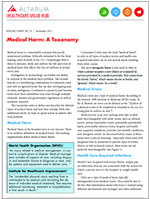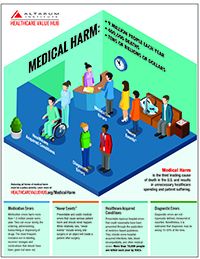Improving Value
Reduce Medical Harm
A critically important area of excess spending and patient suffering is connected to care that is not only unnecessary, but actually harms patients. Among other things, medical harm includes:
- serious reportable events — more commonly called "never events;"
- hospital-acquired conditions (HACs);
- healthcare-acquired infections (HAIs);
- medication errors; and
- diagnostic errors.
Most medical errors are the result of systems-level problems and not linked to individual performance.1 Moreover, errors leading to preventable harm are almost always multifactorial and the strategies to reduce harm must be multi-disciplinary, as well.2 These systems-level strategies are well-understood but unevenly implemented.3 Policymakers can support harm reduction by:
- Improving the accuracy, breadth and standardization of publicly reported medical harm across all settings
- Aligning financial incentives to harm reduction, such as no payment for serious reportable events, reducing payments to the lowest performers
- Make the National Practicioner Data Bank—a database of all state and federal actions against US physicians, including malpractice settlements—available to the public. Currently, the data is available, but the names of doctors are confidential.
- Establish a National Patient Safety Board—similar to the National Transportation Safety Board or the Consumer Finance Protection Agency—to represent the interests of patients/consumers by monitoring, investigating and promoting healthcare system changes that will lead to the elimination of medical errors.
Many experts lament the lack of progress in addressing medical harm since the IOM released its landmark report, To Err is Human, in 1999. Let's not let another 20 years go by.
Notes
1. Nacioglu, Ahmet, "As a Critical Behavior to Improve Quality and Patient Safety in Health Care: Speaking Up!" Safety in Health, Vol. 2, No. 10 (2016).
2. Bernazzani, Sophia, "Tallying the High Cost of Preventable Harm," Costs of Care (October 5, 2015).
3. See: The National Patient Safety Goals of The Joint Commission for checklists related to different healthcare systems, https://www.jointcommission.org/en/standards/national-patient-safety-goals/. See also: Bernazzani, Sophia, "What Hospitals Can Do To Curb Adverse Events, Preentable Harm," Fierce Healthcare (November 24, 2015).








